Get inspiration from companies that excel in providing exceptional omni-channel experiences and learn how to create your own
October 23, 2023
Omnichannel Marketing: Definition, Tips, and Examples
What is Omnichannel Marketing?
Omnichannel marketing, by definition, seeks to unite diverse communication channels into a single system to enable a seamless customer experience when interacting with a brand. When implemented correctly, customers should feel equally comfortable using a single channel or navigating between multiple channels (such as your website, mobile app, physical stores, etc.).
This marketing approach helps brands increase flow effectiveness, reduce communication costs, gain customer insights, and boost customer loyalty. In this article, we’ll take a deep dive into omnichannel marketing using examples from our clients, including Decathlon, Tefal, Burger King, 12 STOREEZ, and others.
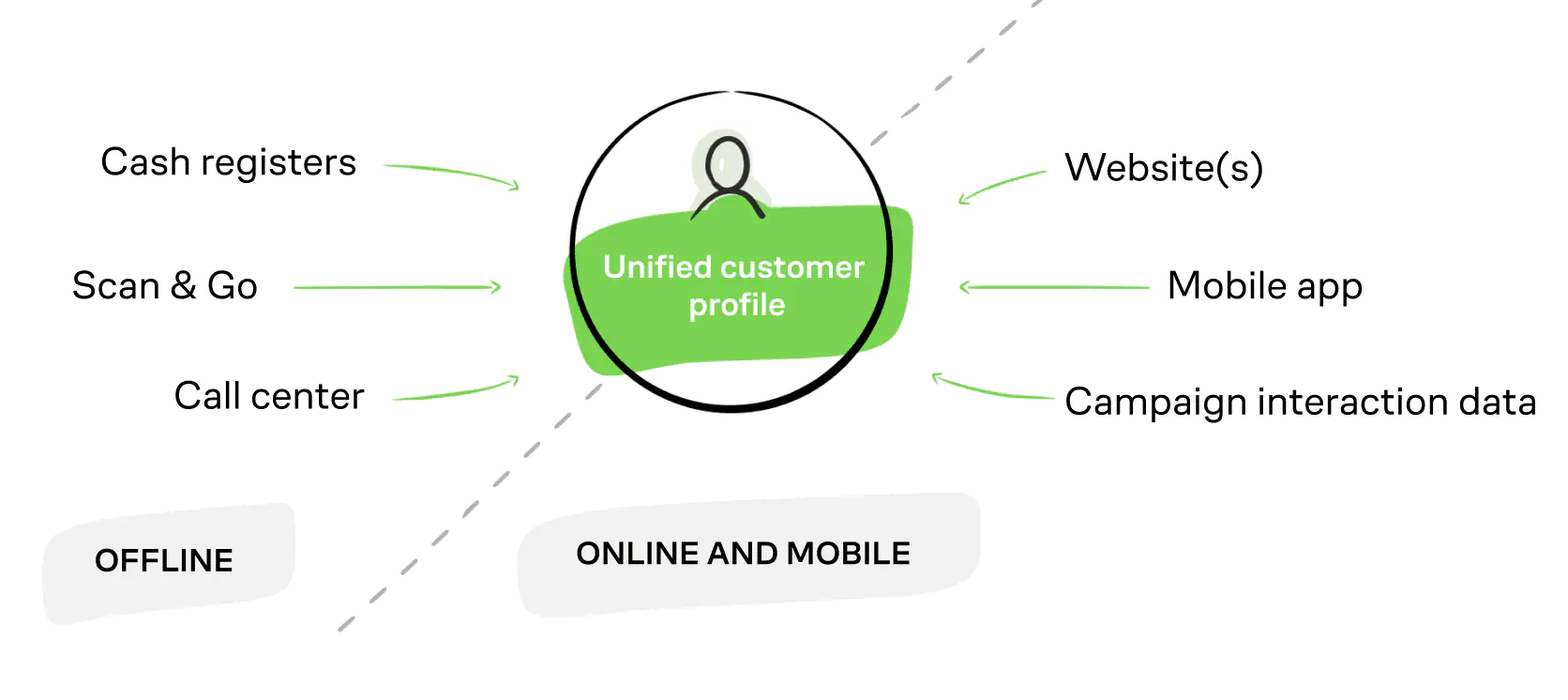
An example of what an omnichannel strategy may look like
How Omnichannel Marketing Works
Let’s use a real-life example to illustrate how a business works with and without an omnichannel approach.
Example 1: No Omnichannel Strategy

In this example, Nick used 3 channels: the website, mobile app, and offline pizza restaurant. Unfortunately, the pizzeria lacks an omnichannel strategy, and as a result, customer data has not been synchronized across these channels. Consequently, Nick had to manually add the pizza to his basket (either virtually or physically) each time he interacted with a new channel.
This situation can be detrimental to both the business and the customer:
Customers have no choice but to start their order from scratch every time they use a new channel. In the given example, Nick had only ordered one pizza, but it’s easy to imagine how tiresome the experience would become if he had multiple items in his order.
From the pizza restaurant’s perspective, their customer data analysis would treat each interaction as a separate Pepperoni-loving customer — one on the website, another on the mobile app, and a third at the restaurant — even though it’s all the same person. If the pizza chain sends Nick a message about an abandoned cart, it may feel like spam because he has already purchased the pizza.
Example 2: With an Omnichannel Strategy
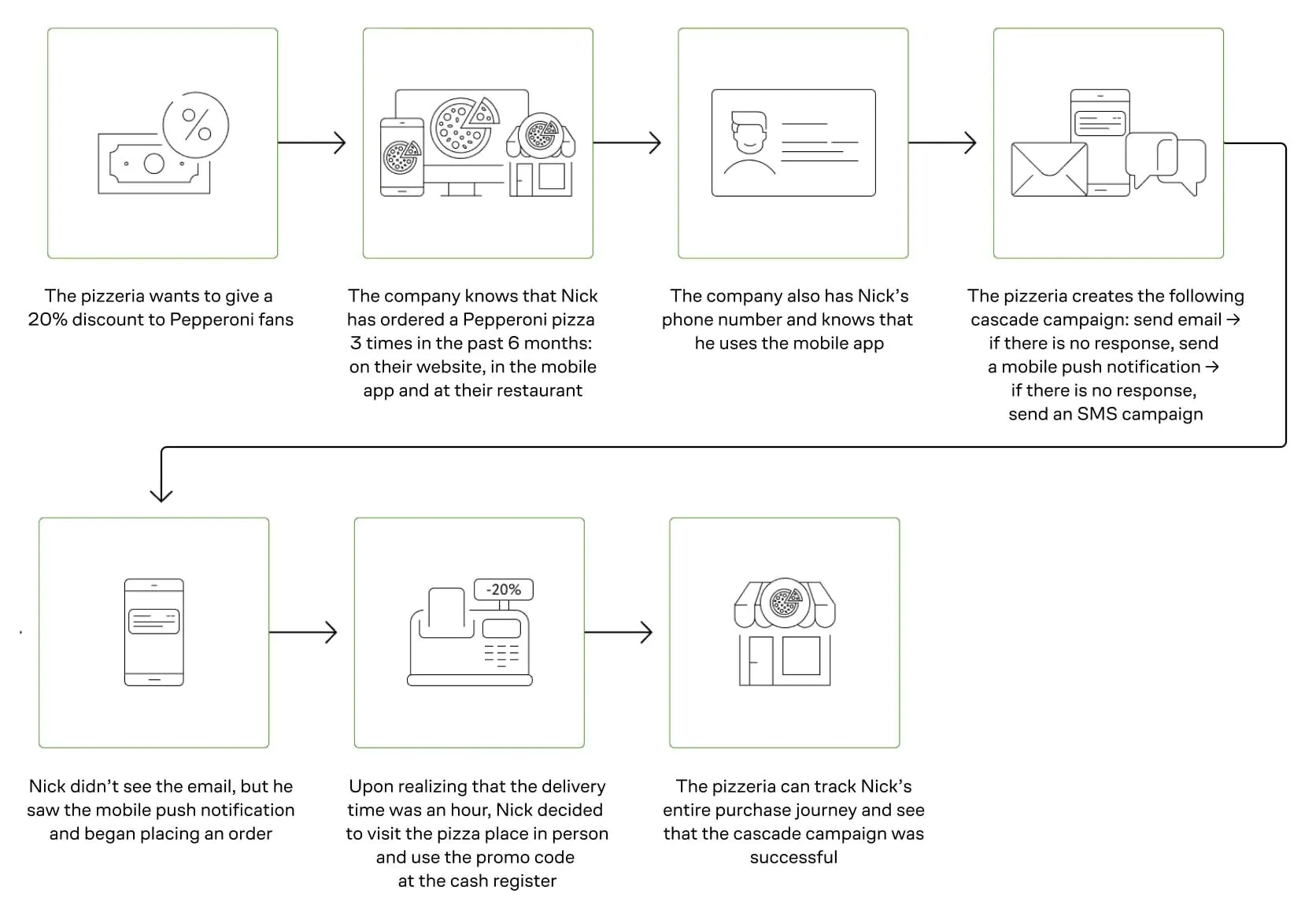
With omnichannel integration, the pizzeria learned that Nick is an active customer with a preference for “Pepperoni.”
Knowing that Nick rarely checks emails but is always on his mobile, they delivered a mobile push notification, ensuring convenience for him.
Using cascading messaging, the pizzeria saved money using free push notifications instead of costly SMS. This adds up when reaching a large audience of 100,000 customers.
Observing that Nick opened the push notification but made an order offline, the company refrained from sending him an abandoned cart message. Instead, they could send him a follow-up message asking if he enjoyed his pizza.
Omnichannel vs Multichannel Marketing: Understanding the Key Distinction
When comparing omnichannel and multichannel, a simple way to distinguish the two is understanding that in a multichannel environment, customers have access to various communication options, but these marketing channels lack synchronization and connectivity. In contrast, an omnichannel experience involves multiple channels that are seamlessly connected, facilitating smooth transitions between them.
The key differences between omnichannel and multichannel marketing strategies can be summarized as follows:
Omnichannel experiences utilize multiple channels, whereas not all multichannel experiences are truly omnichannel. A multichannel setup might include excellent mobile marketing, engaging social media campaigns, and a well-designed website, but without integration, they fail to create a seamless omnichannel experience for customers.
Omnichannel experiences encompass all devices and platforms, whereas a multichannel strategy may only incorporate a limited number of channels. A true omnichannel approach considers all possible channels, platforms, and devices, ensuring a personalized and responsive customer journey across all touchpoints.
Despite most businesses presently investing in multichannel marketing efforts by utilizing email campaigns, websites, messengers, social networks, and other platforms to engage customers, the lack of integration often results in fragmented experiences and inconsistent messaging.
On the other hand, an omnichannel experience takes into account every platform and device customers use to interact with the company, delivering a cohesive and harmonious experience across all touchpoints. This is especially crucial in retail, where adopting an effective omnichannel strategy can significantly impact sales and customer satisfaction.
Omnichannel Benefits
Deeper Understanding of Your Customers
Omnichannel marketing empowers you to gather comprehensive customer data from all channels, including website interactions, engagement with newsletters, and preferred in-store locations. These valuable insights can be harnessed for cross-channel analytics and finely-tuned campaign strategies. For instance, you can send an email notification when a product the customer was interested in becomes available in stock on the website. Alternatively, you can duplicate the message in a mobile push notification if the customer hasn’t opened the email within a day.
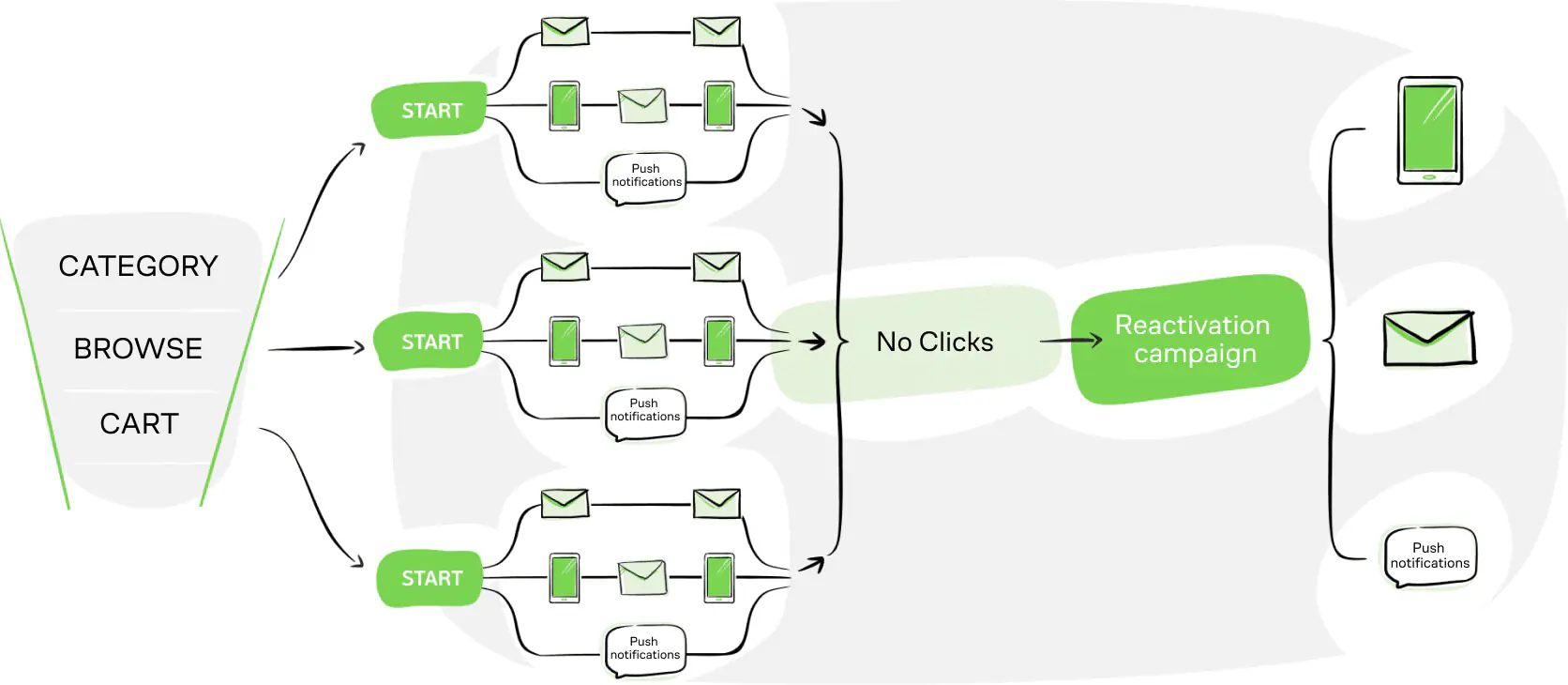
As a brand collects more data, communications with customers become increasingly more intricate and personalized
Increased Campaign Effectiveness
An omnichannel strategy ensures accurate and detailed customer data, enabling better, more targeted campaigns. By understanding individual preferences, you can offer personalized product recommendations and deliver messages where customers are most likely to be more engaged.
This tailored approach significantly improves the efficacy of email campaigns while reducing the number of unsubscribers. For example, the team at Decathlon discovered that their customers are more willing to read bulk campaigns that are sent less frequently (once a week, as opposed to twice a week), with an increase in the open rate and a 35% decrease in the unsubscribe rate. Another example from Tefal showed that the brand’s audience responds well to including their name in the subject line, improving the campaign click rate by 80%.
With an omnichannel approach, your website, app, and offline stores work harmoniously, providing customers a seamless, personalized experience. A purchase that the customer began in your app can seamlessly continue on the website, and any ongoing website promotions will apply in-store as well. This consistency across all touchpoints ensures that customers can comfortably engage with your brand through any channel of their choice.
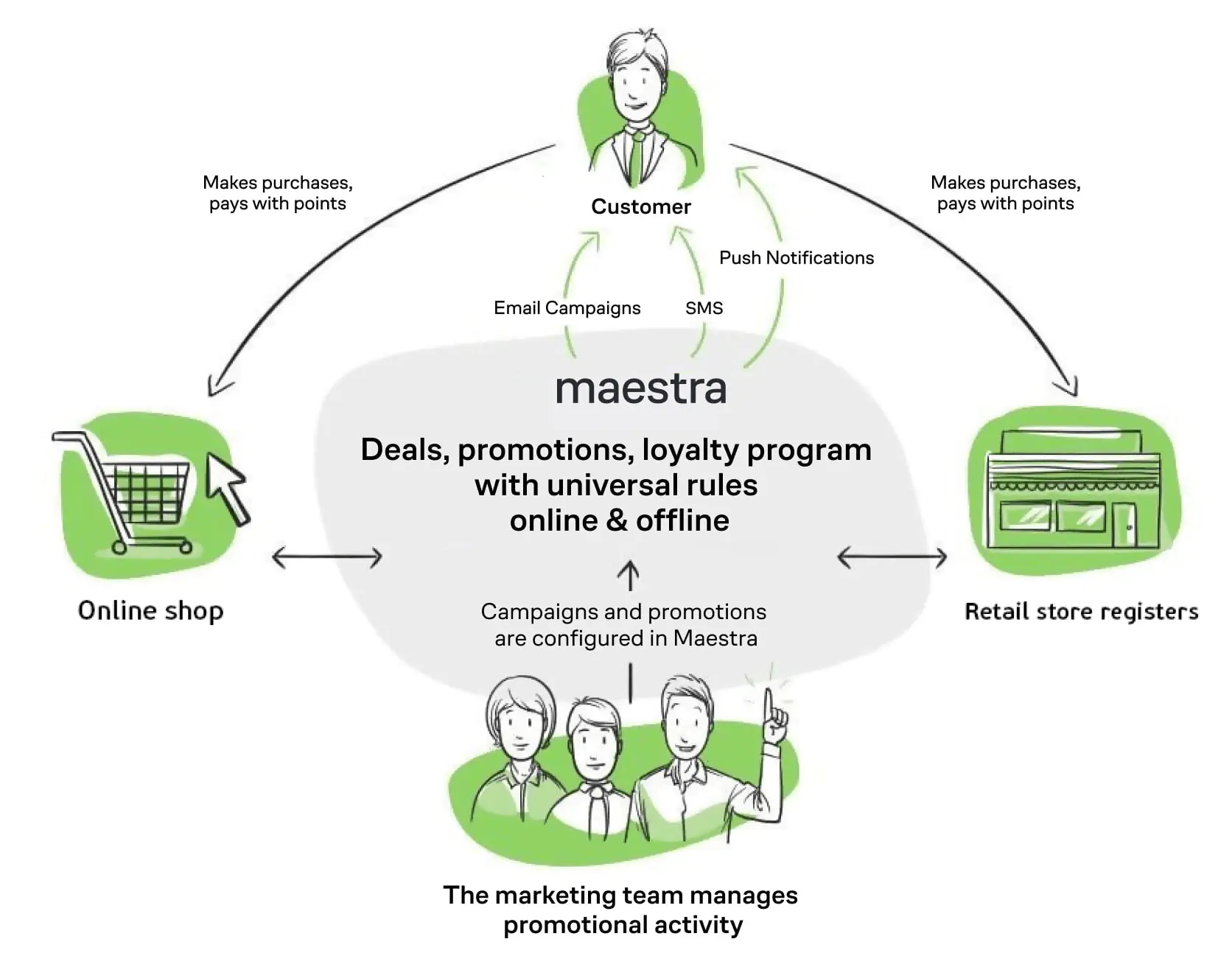
A representation of what United Colors of Benetton’s omnichannel system looks like. Keeping promotions, discounts, and loyalty program rules consistent across all channels provides a seamless experience for customers
Enhances Value Without Spam
Omnichannel marketing brings significant value to customers by preventing message duplication across various channels. For example, if a customer makes an offline purchase, they won’t receive redundant emails or push notifications offering the same product or its alternatives.
Dodo Pizza demonstrates a great example of defeating spam. By adopting an omnichannel approach, the company’s 91 franchises could avoid bombarding customers with repetitive SMS messages. Instead, customers now receive promotional offers via SMS or messaging apps, ensuring a seamless experience without message duplication across channels or from different franchise senders.
Seamless Communication Through Preferred Channels
Omnichannel marketing enables more precision when it comes to messaging. For instance, consider a company that has integrated various channels into its strategy.
If a customer’s profile is complete, communication starts with cost-effective and swift mobile push notifications. Next in line is email, followed by web push notifications, and finally, a messaging app, such as WhatsApp.
For customers with only an email address, messages are sent via email. If the company only has their phone number, they can send a message via SMS or WhatsApp. In cases where limited information is available, but the customer has consented to web push notifications, communication will occur through the website.
This approach enables the company to connect with its entire customer base, using the most suitable channel for each individual, without excluding those who prefer mobile apps or have only provided a phone number.
More Cost-effective Campaigns
To cut down on high-cost channels, cascade campaigns and segmentation prove to be highly effective. Take fashion retailer 12 STOREEZ, for instance, which managed to save over $4,000 in just two months by choosing push notifications over SMS messages. Businesses can optimize resource allocation and focus their efforts where it matters by identifying the channels most frequently used by customers.
Furthermore, consolidating email, mobile and web push, and SMS messaging services into a single omnichannel marketing solution offers a seamless and cost-efficient approach, significantly reducing monthly expenses.
Faster Campaign Launches
With omnichannel synchronization, the process of deploying campaigns becomes much more swift and efficient. This is only magnified when you consider that campaigns across all channels can be set up within one window, instead of multiple different platforms.
As a result of transforming its marketing and unifying its channels, Burger King, for example, achieved the following:
- Campaign launch time reduced from a week to just two hours.
- Checkout issues are now identified quickly: all integration error notifications from Maestra (where dish cost recalculations with promotions are now managed) are instantly sent to Burger King employees’ email addresses.
Omnichannel Disadvantages
Challenging to Implement into an Existing Business
Integrating omnichannel capabilities into an already established marketing strategy can be a complex endeavor. The key lies in gathering customer data from all channels and aligning them, often manually. With multiple channels at play — including websites, call centers, physical stores, and mobile applications — this process typically necessitates significant investments in technical integration.
A good example is Tefal’s story. The home appliance brand’s team embarked on a journey to implement a full-fledged omnichannel marketing system and unify data from CRM, email campaigns, and the website in Maestra. The integration process took approximately 2 months, with multiple dedicated employees from Tefal’s team.
Requires Dedicated Team Members
Omnichannel marketing provides a wealth of valuable data, offering insights into online and offline customer behaviors. Businesses can craft effective marketing strategies by understanding which newsletters customers engage with and which ones they ignore.
However, to harness the full potential of this data and create efficient marketing mechanisms, the expertise of a dedicated staff member is crucial. For larger companies, the task might require an entire department with multiple skilled individuals. Having a specialized team ensures that data analysis is thorough and marketing efforts are optimized for the best possible results.
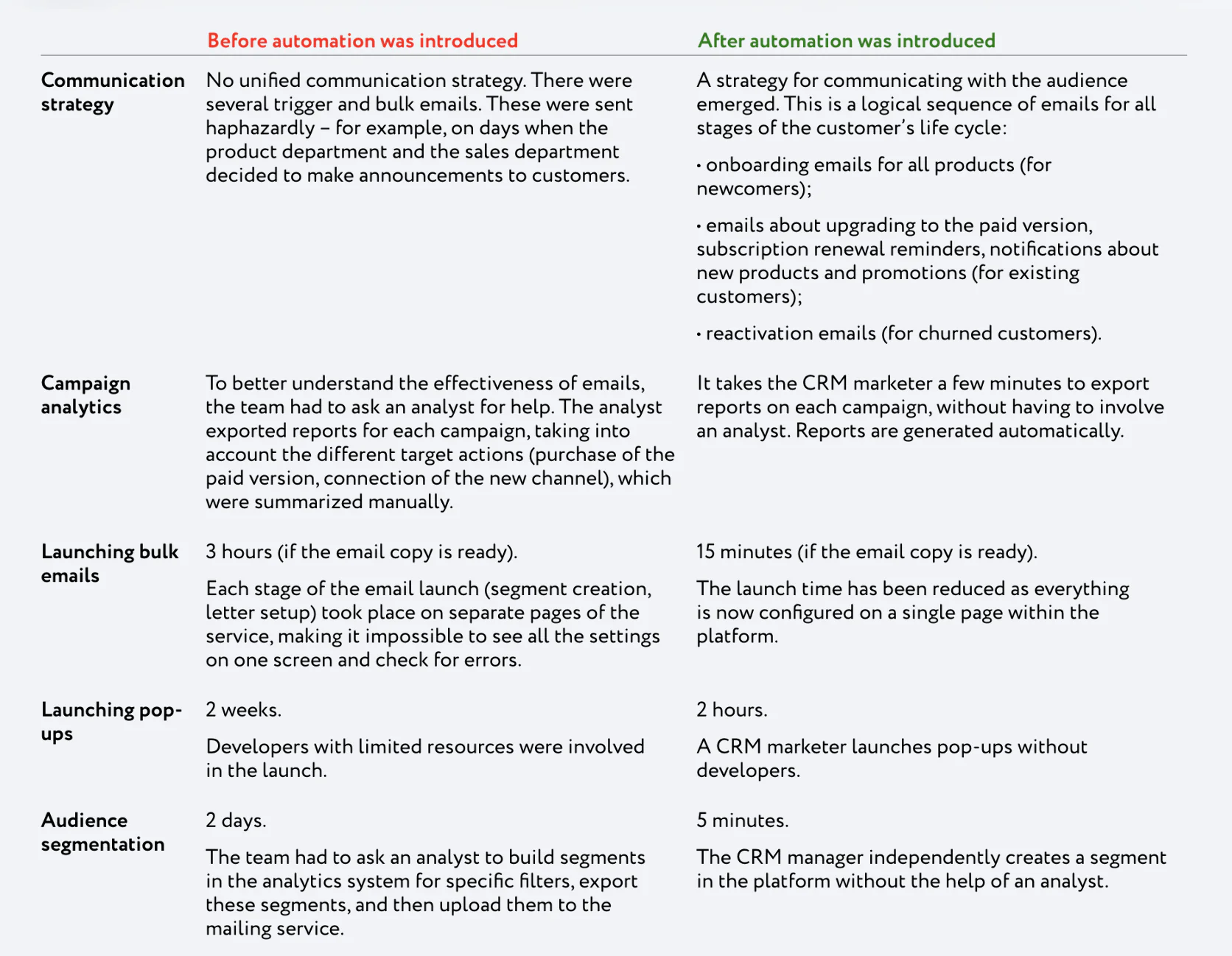
A before and after from our client Jivo: automation helped reduce the IT team’s workload, with marketing tasks now carried out by their CRM marketer in a shorter timeframe
Overall, the benefits of an omnichannel marketing system far outweigh any potential drawbacks and pre-implementation challenges.
Omnichannel Features in Maestra
All Popular Channels Supported
Unlike platforms like Smile.io and Yotpo which only support a few channels, Maestra supports all popular communication channels, including messengers and loyalty programs:
- Email, SMS, mobile, in-app and web push notifications.
- Messaging apps: WhatsApp, Telegram, and chatbots.
- Website personalization.
- Offline: loyalty programs and product recommendations at in-store cash registers.
Marketers can configure omnichannel campaigns, automations, reports, and loyalty programs all in one user-friendly interface. This holistic approach replaces the need for managing multiple services, simplifying your entire marketing process.
Simplified Cross-channel Interaction — No Coding Required
Maestra streamlines cross-channel interactions by aligning messaging based on customer actions across various channels. Setting up segments with the visual constructor is straightforward, eliminating the need for complex SQL programming or developer involvement.
All customer actions are consolidated within a central data repository — the CDP, facilitating the creation of tailored automated triggers for every event — e.g., sending out a campaign, deducting spent bonus points, or adding a customer to a segment.
Data Integrity and Enrichment
Duplicate customer records are identified and merged to ensure data integrity. If a customer who registered on the website later logs into the mobile app, Maestra will consolidate this information into a single unified profile. This prevents customers from receiving multiple identical messages due to data inconsistencies.
Omnichannel capabilities also assist in enriching existing customer data. For instance, METRO enriches this data by asking their audience to fill in birthday details via an email campaign and pop-up.
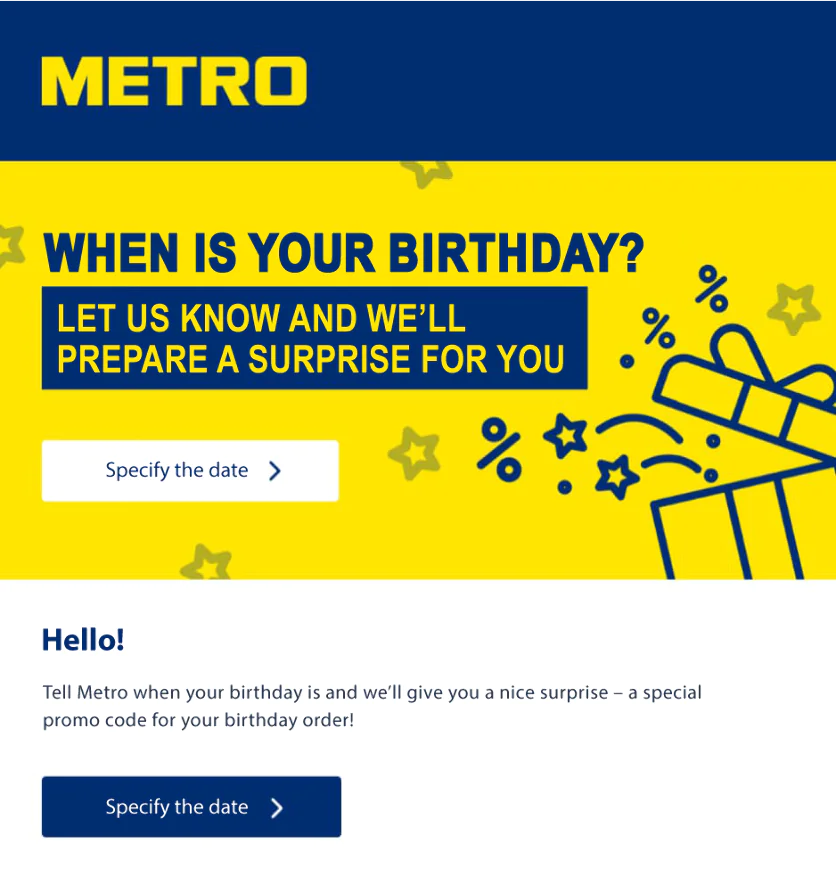
METRO sends customers an email that takes them to the brand’s website
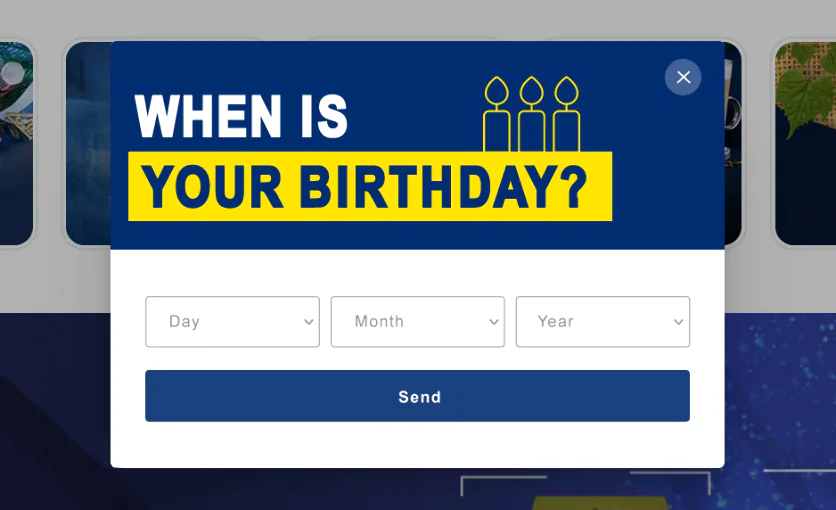
Once the customer fills in their birthday, the data is added to their customer profile and used by METRO to create birthday campaigns and discounts
Hypothesis Testing with A/B tests and Control Groups
Maestra provides marketers with tools such as A/B testing and control groups to measure communication effectiveness. Results can then be analyzed via in-built reports or exported to other analytics systems.
A/B testing allows you to test multiple variants to determine the most effective one — for example, the most effective campaign with the highest conversion rate. This method allows you to make decisions based on hard data. Here are some examples of potential A/B tests:
Hypothesis
Variants
Metric
Emojis in the subject title will increase the open rate by 2%
With and without an emoji
Open rate
Adding a product recommendations block will increase the average order value by ~10%
With and without a product recommendations block
Revenue
A pop-up on the website offering free delivery will increase the order conversion rate by 4%
With and without a pop-up
Number of orders and revenue
In A/B testing, customers assigned to the control group do not receive any marketing campaigns, except for transactional messages. The purpose behind this approach is to compare the conversion rates of customers who received the campaign with those in the control group. The expectation is that the campaign recipients will exhibit a higher conversion rate in terms of placing orders compared to the control group.
For example, Birkenstock used an A/B test to compare the impact of a multi-step email flow with a single email for an abandoned cart campaign:
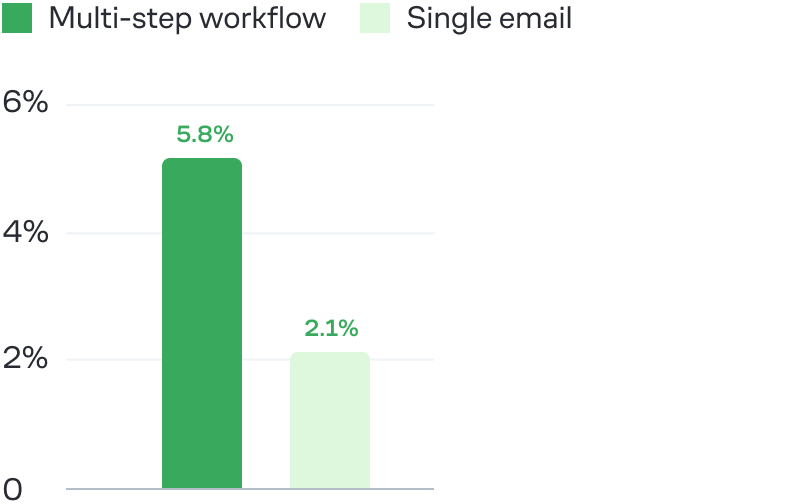
The brand found that a series of email campaigns resulted in a higher conversion rate than a single campaign
Summary
Omnichannel marketing involves integrating different channels to provide customers with a unified and seamless brand experience. An essential aspect of omnichannel is collecting customer data in one centralized location.
Having a single customer profile allows for personalized marketing campaigns and comfortable communication. Customers receive messages at the time that’s convenient for them and through their preferred channel. Companies can optimize costs by employing cascading messaging strategies, starting with cost-effective options like email and push notifications, and resorting to paid SMS only when necessary. The omnichannel approach increases the effectiveness of campaigns while reducing customer acquisition costs and churn.
However, achieving such efficiency comes with challenges, such as the complexity of integration and the need for more advanced marketing management.
Ultimately, omnichannel marketing offers the potential to provide a seamless and personalized customer experience, but it requires strategic planning and careful management to reap its full benefits.
